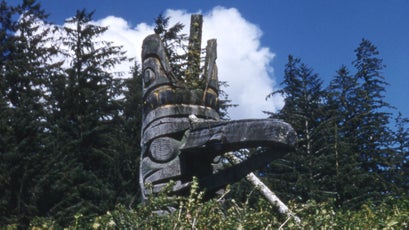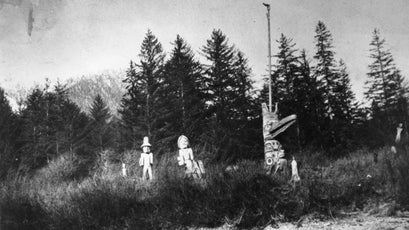Totem Recall: One Chief’s Mission to Reclaim the Past
For more than 40 years, tribal chief and artist Roy Vickers was obsessed with a totem pole that was taken from a remote native village in British Columbia. He decided to make a replica, and all he needed was will, skill, and a 17,500-pound tree.
New perk: Easily find new routes and hidden gems, upcoming running events, and more near you. Your weekly Local Running Newsletter has everything you need to lace up! .
Chief Roy Henry Vickers wants my shirt. I can’t blame him. Faded green checkered Wrangler Retro. Mother-of-pearl snaps. Worn, not dingy. Everybody loves this shirt. Me most of all. I wear it whenever I think cameras might be around.
“You know what you’re supposed to do when you’re in a chief’s house and he says he likes something you have?” Vickers asks.
Some distant raven song bends a note in my mind. I take off the shirt and hand it over.
“All yours,” I say, dying a little inside. Vickers grabs it without hesitation.
“You’ve just done something very traditional in this part of the world,” he says, running a thumb over those flashy buttons I’ll never unsnap again.
“I feel totally authentic,” I say.
This gets a big laugh out of Vickers—pretty much any joke gets a big laugh out of Vickers—because he’s just finished telling me that there’s no such thing as authentic. Also, he really digs the shirt. As Roy has said, “I’m an Indian cowboy.”
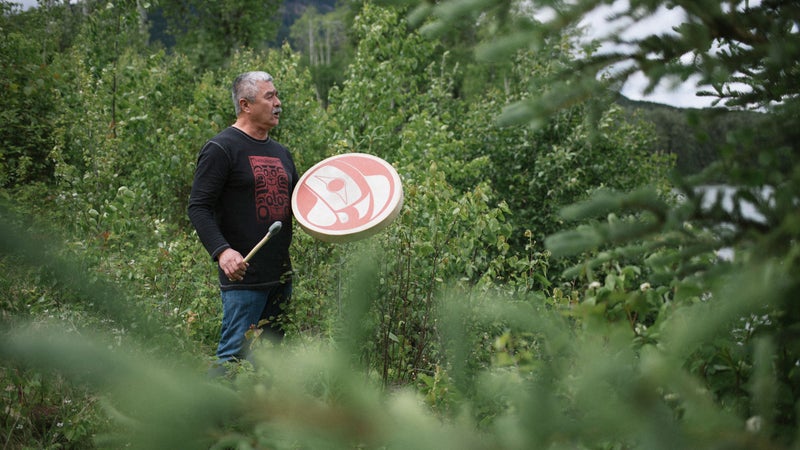
If it seems unlikely that a 72-year-old First Nations chief and one of —who happens to be in the midst of carving a replica of a famous totem pole, which he calls the biggest and most intimidating challenge of his career—would take time to pilfer a piece of shitkicker plaid off a visiting whitey, you don’t know much about Roy Vickers.
Or about this part of the world, a First Nations outpost in northern British Columbia called the Skeena Valley. Here, the difference between a gift and a theft isn’t always so easy to discern, and the payoff can take generations to play out.
For a work of art considered to be one of the most aesthetically advanced of its type, a surprising amount of mystery surrounds the totem pole that has consumed Roy Vickers for decades.
People can’t even agree what to call it. In Vancouver, at the (MOA)—where the pole commands pride of place amid one of the world’s most important collections of Northwest Coast Native art—curators refer to it as the Raven Pole, because there’s a discernible image of a raven (along with two eagles) on its face.
Originally it was 21 feet tall, but because of damage to the bottom section it’s now less than 18. Vickers insists that the totem, which has a distinctive 11-foot-long beak, depicts not a raven but a mythical bird known as a hok hok, a fearsome creature that crushes human skulls. Lately he’s taken to calling it the Hosumdas Totem—hosumdas being a term used to denote the head chieftain of B.C.’s Oweekeno people.
No one knows who carved the pole or when it was raised. The MOA says circa 1890. Vickers guesses it could date back to the mid-1800s. But at this point it’s impossible to be sure.
Vickers insists that the totem, which has a distinctive 11-foot-long beak, depicts a mythical bird known as a hok hok, a fearsome creature that crushes human skulls.
There’s also disagreement about how the pole got from its location near the village of Oweekeno to the MOA. The museum’s website says it acquired the pole from the British Columbia Totem Pole Preservation Committee in 1956. (The committee, now defunct, was a partnership of business and academic interests, formed to purchase and preserve totem poles around the province.) It wasn’t put on display until many years later. Vickers and the eldest person in Oweekeno—his ninety-something Auntie Evelyn, who happens to be one of 50 people who speak the critically endangered Oweekeno language—believe that someone, possibly loggers, may have taken the pole from the village in the 1960s.
When I first heard about the pole, it supposedly had been stolen around the turn of the century. This is not implausible. , and subsequent amendments, became the tacitly genocidal legal instrument through which the Canadian government suppressed First Nations cultures across the country until reforms began in the 1950s. In addition to tearing families apart and forcing children to attend residential schools, the Indian Act outlawed the custom of potlatch, a gift-giving feast that included the raising of totem poles, crucial to Northwest Coast indigenous identity.
The decades that followed, roughly 1875 until the 1930s, are referred to as the Great Scramble—a period when the landmark museums of America and Europe, and a handful of private collectors, ransacked the Pacific coast, plundering almost all known First Nations art. With their exotic representations of ravens, eagles, bears, killer whales, beavers, frogs, and other fauna, totem poles have long transfixed outsiders. In his book , Douglas Cole grimly describes the white world’s locust determination to “salvage in the last hour a residue of a dying culture.”
One thing everyone does agree on is that the Hosumdas Totem originally served as a house-entry pole for Oweekeno chief Simon Walkus, who died in 1913. Like the unknowable designs carved into the pole itself, the rest remains an intricate puzzle.
In the 1970s, Vickers visited the MOA regularly to study the art of his ancestors. Each time, he felt an inexplicable pull from the pole. Something about the abnormal artwork—except for the raven and eagle faces, the pole is mostly free-flowing, abstract designs—and the remnant spirit inside the wood wouldn’t let him go.
“In those days, you could walk right up and touch it,” Vickers remembers. “Growing up in Kitkatla, we used to climb on the old totem poles. No one told us not to. No one said they were sacred.”
In 1994, an unexpected development sent Vickers on what he now sees as his destined journey. After a long association with an Oweekeno family, Vickers—whose ancestry is Tsimshian, Haida, Heiltsuk, and English—was adopted into the House of Walkus, hereditary chieftains in Oweekeno. He had suddenly become the adoptive grandson of an important figure: Simon Walkus, the chief who owned the pole, which stood in front of Walkus’s house for decades.
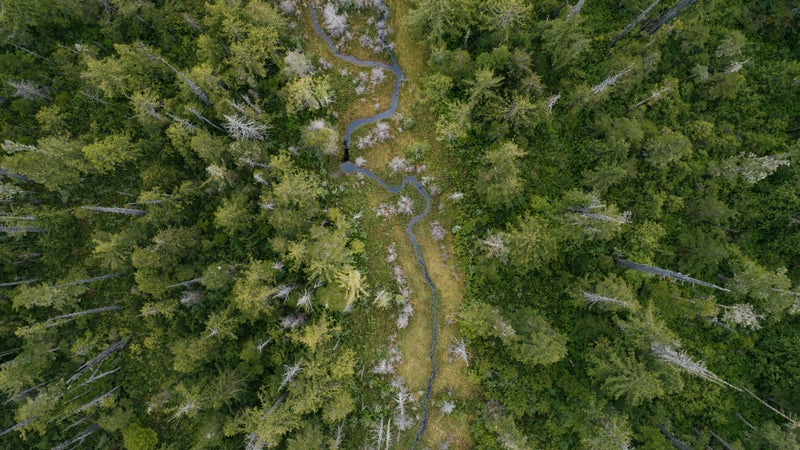
By this time, Vickers had become a wildly successful artist. His was a tourist destination. A mini cathedral of cedar, it now draws 500,000 visitors a year from around the world. He’d created major works of art for the 1994 Commonwealth Games in Victoria and was an adviser for the opening ceremonies at the 2010 Winter Olympics in Vancouver. In 2006, he received the Order of Canada, the nation’s second-highest civilian honor. His painting A Meeting of Chiefs had once been presented as an official state gift to Queen Elizabeth II. (Vickers now howls at the memory of that. “My painting, a gift to the queen of the colonizers!”) In 2018, he designed the bentwood box and all the artwork for the Grateful Dead’s 19-disc box set .
In 2014, Vickers decided he needed to do something about the pole, whose presence in the university’s museum he’d come to resent as a literal representation of cultural theft. Canada’s Truth and Reconciliation Commission was then in full swing, promoting explicit acts of healing between the government and the First Nations. Petitioning the museum to repatriate the pole back to Oweekeno made sense as a symbolic gesture. But transporting the fragile wood to the region could have damaged it further.
Gradually, the idea of carving a full-size replica began taking shape. A new pole would embody a reborn spirit. It also fit the modern fashion for reconciliation. You hear that word a lot in Canada these days, though when I mention the theme to Vickers during my visit last June, his usually cheerful expression clouds over.
“Reconciliation is a political word some people have put together to mean something,” he says, standing in his open-air workshop, sounding a lot like Morgan Freeman sitting in front of the parole board in : “Rehabilitated? … I know what you think it means, sonny. To me it’s just a made-up word. A politician’s word.”
“It’s not even possible in this world to reconcile the cultural genocide that’s happened to our people,” Vickers says. “You can’t fix it. You can’t make cultural genocide better. What is possible, what I want, is to regenerate a new culture, a new strength for people who seem to have lost their power. It’s not lost. I’m proof.”
Vickers had the will, but even for a man of limitless vision the way forward seemed unclear. The original pole was carved from a red cedar so massive that, Vickers estimates, it was probably 1,000 years old. In addition to permission and cost, the logistics of finding, felling, and hauling a centuries-old tree out of the dense B.C. backwoods seemed beyond his considerable abilities.
Then the spirits of the ancestors intervened—at least, that’s how Vickers sees it. On a sunny summer evening in August 2015, at a fishing lodge not far from Oweekeno, Vickers was introduced to a couple of middle-aged logging men who were in from Vancouver. Because he’s a storyteller, he began telling the strangers about the Hosumdas Totem.
I bought into Roy's dream right away,” says Ric Slaco, chief forester at Interfor, one of the world's largest lumber producers. “I said, 'we'll get a log for you.'”
“If I wanted to find a really big cedar for a totem pole, who would I need to talk to?” Vickers eventually asked.
“How big?” one of the men replied.
“About two meters in diameter,” Vickers said.
“Well, after jumping through a lot of hoops, eventually you’d have to talk to me,” the man said. “I’m Ric Slaco, vice president and chief forester at Interfor.” The Canadian company is one of the world’s largest lumber producers.
Later, when I repeat this piece of remembered dialogue to Slaco in downtown Vancouver, he says that’s exactly how it went down.
“You could just see it was something special. I bought into Roy’s dream right away,” Slaco says. “I said, ‘We’ll get a log for you.’ ”
On February 1, 2016, Interfor flew Vickers and Ted Walkus—his adoptive brother and the hereditary Oweekeno chief—into the Great Bear Rainforest to look at seven monumental cedar trees identified by field crews as totem candidates. None of the first trees were quite right—too wide, not straight enough, not… sincere enough, to borrow from Linus Van Pelt.
“You look for a spiritual connection to the living,” Vickers says. “Each tree is like a human being, with its own personality. Same with people. Usually, something will jump out at you.”
As the men continued their search in the Sandell River Valley, the last tree they hoped to see was the most difficult to reach, requiring a tough hike. Vickers was walking on a four-times-broken, 69-year-old ankle and a couple of cracked neck vertebrae, the result of being thrown from a horse. Both eyes would soon require surgery. But when he saw the tree, which probably weighed 17,500 pounds with all its limbs, he had no doubts.
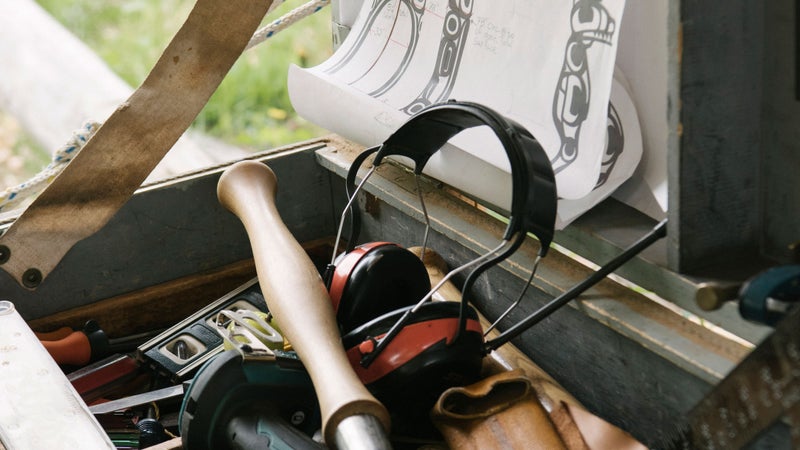
“As soon as we saw it, Ted and I put a hand on the tree and started crying,” Vickers says. “We knew it was the one.”
After the men delivered a traditional blessing, a crew moved in and dropped the ancient tree in less than an hour. To accommodate its massive girth—its widest diameter was roughly 16 feet—they doubled up on the number of thick steel cables typically used for such operations. A Sikorsky Skycrane heli-copter lifted the great log out of the forest.
By his own accounting, Vickers has carved some 30 totem poles. But when he began to examine the Hosumdas Totem—during multiple trips to the MOA, which let him in before opening hours to take measurements and photos—he noticed something he’d never before appreciated. From top to bottom, the pole has a unique sense of flow that’s different from typical pole designs, which tend to feature a stack of distinct sections.
“The artist who carved this pole was way ahead of his time,” says Vickers. “When I began trying to copy his work, it twisted my mind. This brilliant artist also had the courage to do something totally out of the ordinary. There was no carver alive who could help me understand what he did.”
Without the aid of a computer, much less tracing paper or a ruler—Vickers guesses that the carver probably did his designing with a pencil, string, and some pieces of bark—the artist had rendered a 2-D design onto a 3-D pole with supernatural accuracy.
In his workshop, with the new Hosumdas Totem about two-thirds complete, Vickers walks me around it, explaining the innovative design in musical terms. In the same way a visionary composer might juxtapose major and minor keys and sharps and flats in ways that break convention, the pole’s sections and shapes—ovoids, nested ovoids, U’s, split U’s, elongated S’s—flow together like nothing Vickers has ever seen.
“He took the totally rigid forms of Northwest Coast art and bent them to his own way of design,” Vickers says. “I am certain this pole is one of the most powerful statements a chief on this coast has ever made.”
Music has long been a big part of Vickers’s identity. In conversation, he’ll spontaneously burst into one of the elegiac songs of his ancestors. One afternoon, he picks up a custom-made guitar—featuring cool raven-shaped sound holes—and sings me a haunting version of “Drums,” Johnny Cash’s virulently anti-colonial lament, delivered from the view of “just another empty Indian.” It’s an inspiring and unsettling interlude in his work on the pole.
“A carver who doesn’t sing and dance doesn’t get it,” Vickers says.
Vickers knew he couldn’t carve the new Hosumdas pole alone. Using hook knives, chisels, and adzes to “move wood” on a giant log demands Sasquatchean strength and endurance. After a lifetime of abusing his body, Vickers has no business carrying a load of laundry down to the basement.
In the 1970s, he fractured three vertebrae after being thrown off a rodeo bronc. He broke a bone in his face, lost four teeth, and fractured vertebrae in his neck in a motocross wipeout. His oft-broken ankle finally had to be fused in 2016. In 2017, he had surgery in both eyes to repair corneal growths likely caused by excessive exposure to sun, wind, and dust.
To complete the pole, Vickers assembled a dream team of carvers. One was , a gifted Nuxalk sculptor originally from Bella Coola who makes masks that sell for well into five figures. He was brought in to help finish the pole’s raven face and beak, and to texturize the overall piece. Another recruit was an artist and instructor known throughout B.C. A Tlingit-Kaska from the Yukon, he says he had to adjust to what he refers to as the pole’s “southern style.”
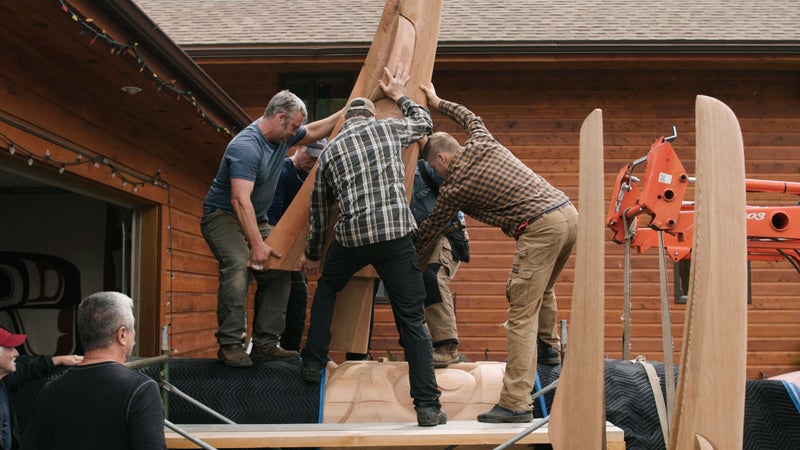
“There’s only one V cut on this entire pole,” he says, pinpointing a typical difference between Tlingits and carvers down the coast. “All I did was work on the model pole the first two weeks I was here. The hardest part was figuring out the face.”
The linchpin of the operation—the first person Vickers asked for help—is a local timber framer named Matt Lewis. Vickers calls him Magic Matt, and anyone who’s ever employed the hit-or-mostly-miss services of an independent contractor quickly learns to stand in amazement at Lewis’s brute strength, feather-touch artistry, and beers-can-wait work ethic. It was Lewis who muscled out the raw form of the pole’s 11-foot beak, cutting with a Husqvarna chainsaw.
“It’s a mind-fuck to get it right,” Lewis says, marveling at the complexity of the
totem’s design. “We measured it and broke it down into sections, but this isn’t the same piece of wood as the original pole. You can spend a lot of time chasing a knot around.”
Lewis is white—his father was a conscientious objector who moved to Canada from California to escape being drafted during the Vietnam War—and his centrality to the project raises another knotty point: the question of authenticity. Vickers has heard grumblings within the community.
“No one has the nerve to say something like that to my face, but someone will tell me so-and-so said this and that about my methods,” he says. In fact, Vickers has been defending the use of chainsaws, computer-aided design, and nonindigenous carvers as far back as the 1990s, when he started using Aldus FreeHand to draw totem templates.
“To me it’s almost like one of the ancestors created that program, it’s so suited to this type of design,” he says. “I admit there was a time I felt guilty about it, but these are the tools of our time, and we utilize them for our traditional art, just as past generations used the technology available to them.”
“Our ancestors weren’t dumb,” adds Mack. “When they got steel introduced, the first thing they did was make knives and blades.”
Vicissitudes of history aside, paternalistic worries about the ethnological integrity of Native art are almost as old as the market for that art. By the 1870s, white collectors were already expressing concerns about philistine influence on aboriginal art, as though Native cultures should remain preserved in amber for the cognoscenti’s aesthetic pleasure.
“One can only shake his head sadly to see art so corrupted and debased,” wrote an 1880s travel writer named about the evolving state of the silverwork she found among Stikine carvers in Wrangell, Alaska.
A commercial artist himself, Vickers knows that the prejudices of the marketplace have scarcely changed. When I offer an example, he finishes the scenario before I can.
When a shroud is cut away and the golden cedar pole shines in front of the village’s big house, the 250 or so guests gasp, then break into a sustained cheer and trilling whoops.
“If a novice indigenous carver makes a halfway decent Haida mask, he might sell it for $1,000 in a Vancouver gallery,” I say. “But let’s say a Jewish woman from New York studies Northwest Coast art for decades and masters the form—”
“She can’t even give her work away!” Vickers shouts. “There are millions of people who think this way—including many First Nations people—but there’s no substance to it. Stopping a white man from carving a totem pole isn’t protecting the culture. It’s dividing people.”
“I notice it’s never anyone with a tool in their hand complaining about authenticity,” Lewis says, noting that this is the fifth pole he’s worked on with Vickers. “This pole was logged with a helicopter, eh? So where are we going with this?”
Oweekeno is a one-dirt-road village sited in a remote fjord on the hard-charging Wannock River, year-round population roughly 80. To get there last July for the potlatch and pole unveiling, I join 40 or so people in Port Hardy for a ten-hour trip on the Buttle Shuttle, a converted 1950s ferry that chugs up Rivers Inlet. July rains obscure some of the most epic scenery on the coast, but when we dock the skies lift, revealing a -landscape of vertical valleys and mountain peaks shaped like cedar hats.
Standing beneath a roaring 200-foot waterfall—anywhere else, they’d dedicate calendars and heli-seeing flights to such a natural wonder; here it’s just called Piss-Piss Falls—Vickers waves us in.
“It’s always like this before a potlatch, thunder and lighting,” he tells me. “That’s the Thunderbird welcoming visitors.”
Family and friends from up and down the coast hug, then load boxes of potlatch booty into a phalanx of muddy trucks. Vickers’s eyes go red and puffy.
“I’ve been like this all week,” he says, his voice abruptly becoming hesitant and thick. “It’s really happening.”
The legendary giveaways for which potlatches were partly banned (authorities believed they were bankrupting villages) were always only a small part of the tradition. The Walkus family potlatch is typical. Over the course of two nonstop days—endurance is a big part of the potlatch program, and newbies are rightfully terrified by the endless speechifying of old-timers—ceremonies are dedicated to honoring ancestors, noting recent deaths and births, settling disputes, commuting history and culture through song and dance, fostering business relationships, conducting coming-of-age initiations, gossiping, meeting potential mates from other villages, and lots of eating, which in Oweekeno means successive meals of salmon, elk, halibut, and crab.
The unveiling of the Hosumdas pole kicks off the festivities. When a shroud is cut away and the golden cedar pole shines in front of the village’s big house, the 250 or so guests gasp, then break into a sustained cheer and trilling whoops.
“We want to gift this to the community,” says tribal chief Ted Walkus. “This isn’t us, the Walkus family, putting our pole up there. This is us bringing something home that will enrich every one of us.”
Back when it was on its side, sitting on sawhorses back in Vickers’s carving shed, the pole was impressive. Now, standing up, it seems three times larger and more powerful. All weekend people gather at its base to talk. As if drawn by instinct, children keep returning to play in its imposing shadow.
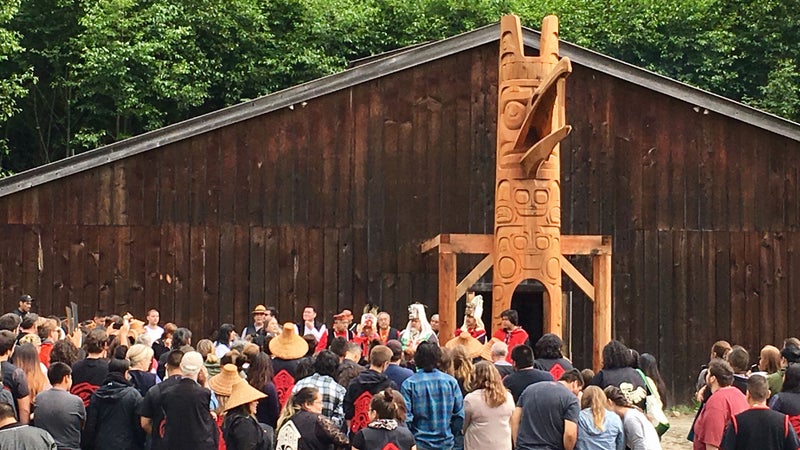
During the potlatch, Ric Slaco is honored before the tribal chiefs, presented with a six-foot-tall replica pole and invited to join a dance. Everything at the potlatch moves counterclockwise around a great fire that’s positioned in the center of the dirt-floored big house, giving an increasingly hypnotic aura to the proceedings.
Vickers’s emotions overflow on the second day, when he formally adopts each of the three carvers—Lewis, Heron, and Mack—into his family. Lewis is given the Oweekeno name Saeis, meaning “cedar mat,” acknowledgment of his prolific facility as a woodsman and a humorous play on his given name, Matt.
After the adoption ceremony, I chase down Paul, the soft-spoken, middle-aged Oweekeno man in charge of bestowing honorific names to adoptees. I want to pin down the English spelling of Lewis’s tribal name. Paul doesn’t seem to appreciate my zeal for fact-checking.
You could start the name with an S or an O or an X, he advises unhelpfully. I turn my notebook around and show him my transliteration: Saeis.
Paul shakes his head, then scans the horizon for some imaginary spirit. There’s no way to accurately convey what a dork I feel like at this moment.
“Maybe. The last sound is too difficult to translate,” he finally says.
The meaning in his grimace is clear. Write it down however you want, it says. You’re gonna get it wrong no matter what.
“We’ve always underestimated the power of the written word,” one elder says during the potlatch. “Our culture can only be understood through visions and dances.”
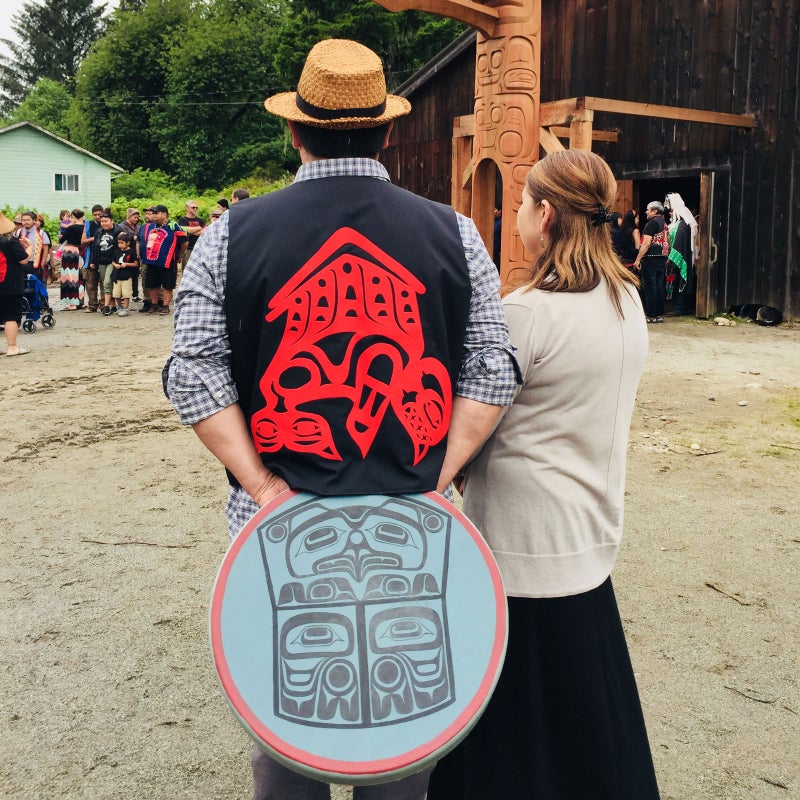
That’s undeniable—no business is finished at a potlatch until it’s been sealed with a performance—but for Vickers, nothing conveys the culture like a blade moving through cedar, transforming a historic theft into an improbable gift.
“It doesn’t matter how or why the pole was taken from the village,” he told me before the festivities got underway. “I’m glad it happened. The museum acquired it and valued it. If not for that, we wouldn’t have created this monument today.
“Think about this,” he adds. “Not so long ago it was illegal to do what I’m doing, just carving a pole for a potlatch! It feels like I was meant to do this. It feels like everything I have done in my life is all about getting this pole done.”
Through the rain, you could see what a relief it was to finally move on.
Chuck Thompson () wrote about whitewater paddling on British Columbia’s Klinaklini River in July 2016.



